Abstract
This study investigated the transpiration rate (TR) of pomegranate (Punica granatum L.) arils under various combinations of temperature (5, 10 and 15°C) and relative humidity (RH) (76, 86 and 96%) during storage. Transpiration rateTR ranged from 1.14 to 16.75 g/kg day across the various combinations of RH and temperature studied. Relative humidityRH had the most significant impact on TR (p < 0.05). Transpiration rateTR increased six-fold when RH was reduced from 96 to 76%, and correlated well with water vapour pressure deficit (WVPD) (R 2 = 96.1%). Aril weight loss increased at higher WVPD. After 8 days of storage, losses in quality attributes of arils were higher with increasing storage temperature and lowering RH. A mathematical model to predict TR as a function of temperature and RH was developed and successfully validated at 8°C. The target water vapour transmission rate of packaging materials for pomegranate arils was found to be 33 to 68 g/m2 day.
Esta investigación examinó la tasa de transpiración (TT) de arilos de granada (Punica granatum L.) sujetos a varias combinaciones de temperatura (5, 10 y 15°C) y humedad relativa (HR) (76, 86 y 96%) durante su almacenamiento. En todas la combinaciones de HR y de temperatura estudiadas, la TT varió de 1.14 a 16.75 g/kg día. El impacto más significativo en la TT (p < 0.05) estuvo dado por la HR. Al reducirse la HR de 96% a 76%, la TT aumentó 6 veces, constatándose, al mismo tiempo, una buena correlación con el déficit de presión de vapor de agua (DPVA) (R2 = 96.1%). La pérdida de peso de los arilos se incrementó con DPVA más altos. Tras 8 días de almacenamiento, las pérdidas en los atributos cualitativos de los arilos fueron más elevadas con temperaturas de almacenamiento más altas y con una HR más baja. Se desarrolló y validó un modelo matemático que predice la TT en función de la temperatura y manteniendo constante la HR en 8°C. Así, se determinó que la tasa objetivo para la transmisión de vapor de agua de los materiales de empaque para arilos de granada es de 33 a 68 g/m2 dia.
Introduction
Transpiration is one of the critical physiological processes in fresh produce such as fruit and vegetables. Once the produce is detached from the growing plant, it solely depends on its own water content for transpiration (Mahajan, Oliveira, & Macedo, Citation2008). The loss of water from fresh produce results in weight loss and shrivelling leading to unsaleable loss during retail marketing and a direct financial loss. Therefore, appropriate packaging and optimal storage conditions are applied to extend the shelf life of both fresh and fresh-cut produce. Fresh produce such as fruit release large amounts of water vapour and without appropriate packaging, water vapour could build-up inside the package, facilitating the growth of microorganisms (Mahajan, Oliveira, & Macedo, Citation2008). Transpiration rate (TR) of produce during postharvest handling and storage is influenced by intrinsic factors such as surface-to-volume ratio, surface injuries, morphological and anatomical characteristics, as well as maturity stage (Sastry & Buffington, Citation1982), and extrinsic factors such as temperature, RH, air movement, and atmospheric pressure (Chourasia, Maji, Baskey, & Goswami, Citation2005).
Pomegranate (Punica granatum L.) has been well documented for its potential health benefits such as its high antioxidant, anti-mutagenic, anti-hypertension, anti-inflammatory and anti-atherosclerotic activity against osteoarthritis, prostate cancer, heart disease and HIV-1 (Ríos-Romero et al., Citation2012; Viuda-Martos, Fernández-López, & Pérez-Álvarez, Citation2010). Despite these health benefits, pomegranate consumption is still limited due to the difficulties of extracting the arils and the inconvenience caused due to phenolic metabolites which stain the hands during preparation of seeds (Opara, Al-Ani, & Al-Shuaibi, Citation2009). Modified atmosphere packaging (MAP) of ready-to-eat arils presents a more appealing product to consumers and increases the prospect of both production and consumption (Caleb, Opara, & Witthuhn, Citation2012). However, MAP could lead to water accumulation on the product surface due to water vapour build-up, resulting in produce sliminess and enhancement of microbial growth (Song, Lee, & Yam, Citation2001; Song, Vorsa, & Yam, Citation2002; Caleb, Mahajan, Al-Said, & Opara, Citation2012). It is well known that package gas composition is influenced by the respiration rate of the product and the gas permeability of the packaging film. Current MAP design considers the respiration rate of the product as the only important parameter for deciding target oxygen (O2) properties required to achieve equilibrium, mainly O2 which is suitable for the selected product. However, besides in-package gas composition, it is also important to take into consideration the in-package level of humidity for fresh produce, in order to avoid condensation and/or mould and bacterial development in MAP systems (Song et al., Citation2001). Therefore, development of a TR model is necessary for estimating the target barrier properties required from the packaging materials.
Mathematical models for prediction of TR in fresh and fresh-cut (FC) are scarce. This is due to the complex interaction between moisture evaporation on the produce surface as a result of vapour pressure difference and also due to product metabolic activity (Song et al., Citation2002). Various types of mathematical models have been proposed for moisture loss, such as physical dynamic models, based on the diffusivity, semi-empirical as well as empirical models, but, prediction accuracy is critical in control (Ochoa-Martínez, Gallegos-Infante, Morales-Castro, Medrano-Roldán, & Rocha-Guzmán, Citation2004).
Information on the effect of the storage conditions on the transpiration rate of pomegranate arils is lacking. Thus, predicting the rate of water loss is essential for estimating the shelf-life of fresh pomegranate arils. Additionally, proper control of RH in MAP for fresh produce plays a critical role in MAP design and in the produce shelf-life with regard to physico-chemical and microbiological stability (Song et al., Citation2001). The objective of this study was to quantify the water loss of fresh pomegranate arils and develop a mathematical model to relate TR to temperature and RH, and to estimate the packaging needs of pomegranate arils.
Materials and methods
Plant material and sample processing
Commercially ripened pomegranate fruits (cv. Acco) were procured from Robertson valley farm, Western Cape (33°48 ′ 0″S, 19°53′0″E), South Africa and air-freighted in well-ventilated boxes to Process and Chemical Engineering Laboratory, University College Cork, Ireland. On arrival, the fruits were immediately stored at 5°C until the next day when fruit samples were processed in a disinfected cold room at 5°C, by carefully removing the husks to avoid damaging the arils. Free surface moisture on the arils were gently removed using sterile paper towels after which the arils were weighed and equilibrated at 5, 10 and 15°C for 1 h prior to the experiment. Physico-chemical properties of the pomegranate cv. “Acco” studied were characterised at the start of the experiment and the data is presented in . One-hundred grams of arils were homogenised and filtered using cheesecloth. Juice pH was measured using a digital pH meter (3310 Jenway, pH Meter, UK). Total soluble solids (TSS) were measured by a handheld refractometer (Atago, Tokyo, Japan). Titratable acidity (TA) expressed as % citric acid was determined potentiometrically by titration to an end point of pH 8.2 using 2 mL of juice diluted with 10 mL distilled water using an autotitrator (Metrohm 785 DMP, Titrino, Switzerland). Hunter colour parameters (L* (lightness), a* (redness and greenness), and b* (yellowness and blueness)) of arils were measured with a colour meter (Minolta Chroma Meter, CR-300, Japan), after calibration against a white tile background. All analyses were presented as mean ± standard error (S.E.) of 10 replicates.
Table 1. Physico-chemical properties of pomegranate fruit studied.
Tabla 1. Propiedades fisico-químicas de la granadas estudiadas.
Table 2. Quality scores and descriptors for pomegranate arils.
Tabla 2. Puntuación de calidad y descriptores para arilos de granada.
Experimental setup
The experimental setup consisted of nine test containers placed within refrigerating incubators with temperature maintained with ±0.5°C of the set temperature of 5, 10 and 15°C. Relative humidity (RH) within the test containers were independently controlled by using saturated salt solutions of sodium chloride, potassium chloride, potassium nitrate giving 76, 86 and 96% RH, respectively (Mahajan, Oliveira, & Macedo, Citation2008). The salt solutions were made from reagents of analytical grade, using demineralised water. The solutions were supersaturated in order to ensure that the constant RH was maintained throughout the experiment; the temperature and RH within the test containers were monitored continually using a battery-powered sensor (HMP50, Campbell Scientific Inc., Utah, USA). This setup was found to maintain a constant RH throughout the experimental run. The solutions were poured into the test containers and supports were mounted above the solution level with large aluminium pans to hold the Petri-dishes containing the samples.
To evaluate the TR, a weight loss approach was adopted (Leonardi, Baille, & Guichard, Citation1999). Approximately 10 g of arils were placed in a Petri-dish of known weight and aril weight loss was measured daily using an electronic balance (Bosch SAE200, GmbH). Transpiration rate was calculated from the changes in weight over time and expressed as change in aril weight (g) per initial weight of arils (kg) per unit time (day) as shown in the following equation:
Two replicates for each storage condition were used for all analyses and the duration as well as measurement interval was the same for all temperature and RH conditions. Experiments were performed according to a full factorial design with two factors temperature and RH at three levels of 5, 10 and 15°C, and 76, 86 and 96% RH, respectively. The total number of runs was 18. An additional set of experiments with all the combinations of 76, 86 and 96% RH was performed at 8°C in order to validate the mathematical model for TR.
Model building
The flow of water vapour through a fruit is proportional to the difference in water activity (aw ) (RH/100) between the surface of a commodity and the surrounding air. This can be related to Fick's law of diffusion (Ben-Yehoshua, Citation1987). In this model, the RH of fruit internal atmosphere was considered as a first approximation to be 1.0 (or 100% RH). This parameter depends on solute content of the fruit and is slightly less than 1.0. The term (aw − awi ) is the difference in concentration of the water vapour across the pomegranate aril membrane for the direction of flow from awi to aw .
Packaging needs
The ability to create a stable pre-determined RH in sealed packages with the potential for reducing decay problems would be valuable for improving the success of MAP systems. This requires proper selection of packaging film material based on water vapour transmission rate (WVTR). Therefore, the TR model developed for arils was used for estimating the target WVTR required to maintain optimal RH inside the package. The package RH is influenced by TR of the produce as well as by the water vapour permeability of the packaging film as shown in Equation Equation(7). This is a mass balance equation that describes the rate of change of RH or moisture accumulation in the headspace.7
Quality evaluation
Quality evaluation of arils from each of the experimental runs was performed on the eighth day of storage. Colour, firmness and decay of arils were determined subjectively using a 1–5 visual rating scale by adapting visual quality descriptors. Firmness was determined based on the resistance of the arils to slightly applied finger pressure and recorded using a 1–5 tactile rating according to the method described by Nunes, Emond, Dea, and Yagiz (Citation2011) for sliced cucumbers, adapted to pomegranate arils as reported in . The initial quality evaluation of arils on the visual rating scale for colour and firmness were scored as 5 without any form of decay.
Statistical analysis
Pareto analysis was carried out at 95% confidence interval using Statistica software (Statistica 10.0, Statsoft, USA) to assess the effects of RH and temperature, and the interaction between RH and temperature on the TR of pomegranate arils.
Result and discussion
Transpiration rate of pomegranate arils
Weight loss of pomegranate arils during storage at 10°C and 86% RH across the experimental combinations is shown in , which constantly decreased with time at all combinations of temperature and RH studied. Transpiration rate for pomegranate arils as calculated from Equation Equation(1) ranged from 1.14 to 16.75 g/kg day across all the combinations of temperature and RH tested. The TR values obtained in this study were lower than those reported by Mahajan, Oliveira, and Macedo (Citation2008) for mushroom (TR: 6.5 to 92 g/kg day) at 5, 10 and 15°C with RH 76, 86 and 96%. In contrast, the TR values from this study were higher than that of apple (TR: 0.67 g/kg day) at 10°C, 86% RH (Patel, Pai, & Sastry, Citation1988). The high values of TR for mushroom is associated to its lack of a protective skin, therefore, the rate of moisture loss is higher. But, due to a higher surface/mass ratio for smaller fruit this influences TR compared with large fruit, this explains the higher TR in arils compared to apple. Transpiration rate was found to be higher at 76% RH and 15°C compared to 96% RH and 5°C as shown in . The same trend was also observed in TR of mushrooms by Mahajan, Oliveira, and Macedo (Citation2008), therefore, they have expressed TR in terms of per unit surface area of mushrooms. However, considering the uniformity of aril size, TR in terms of per unit weight was considered appropriate for this study. Furthermore, water vapour pressure deficit (WVPD) was calculated from the temperature and RH conditions used in this study as described by Lichter et al. (Citation2011). Weight loss of arils increased with higher WVPD and the effect of WVPD correlated well with TR of arils (R
2 = 96.1%) as shown in . The WVPD in this study ranged from 0.04 to 0.4 kPa and values were highest at the low RH of 76%. Our finding corroborates the Lichter et al. (Citation2011) report, in which they observed the cluster weight-loss increase in grapes with WVPD as well as highest WVPD values at low RH.
Figure 1. Changes in weight loss of pomegranate arils over time. The values were normalised with respect to the initial weight of pomegranate arils (Mi, g); (a) Effect of RH on weight loss at 10°C: ○ represents RH at 96%; Δ represents RH at 86%; □ represents RH at 76%. (b) Effect of temperature at 86% RH: • represents temperature at 5°C; ▴ represents temperature at 10°C; ▪ represents temperature at 15°C. The bars indicate standard error of mean.
Figura 1. Cambios en la pérdida de peso de arilos de granada con el tiempo. Los valores se normalizaron con respecto al peso inicial de arilos de granada (Mi, g), (a) Efecto de la humedad relativa sobre la pérdida de peso a 10°C: ○ representa el 96% de humedad relativa, Δ representa el 86% de humedad relativa; □ representa HR a 76%. (b) Efecto de los temperatura a 86% de HR: • representa la temperatura a 5°C; ▴ representa la temperatura a 10°C; ▪ representa la temperatura a 15°C. Las barras indican el error estándar de la media.
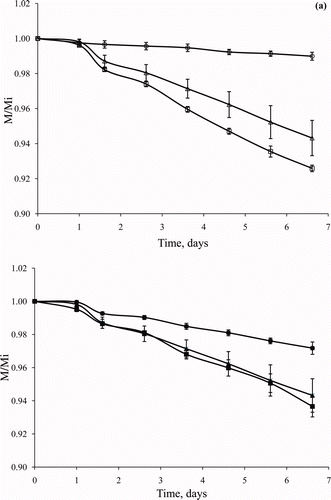
Figure 2. Fitted square surface showing the effect of temperature and RH on transpiration rate (g/kg day).
Figura 2. Superficie de respuesta que muestra el efecto de la temperatura y la humedad relativa en la tasa de transpiración (g/kg día).

Figure 3. Relationship between transpiration rate (TR) and water vapour pressure deficits for pomegranate arils.
Figura 3. Relación entre velocidad de transpiración (TR) y déficit de de presión de vapor para arilos de granada.
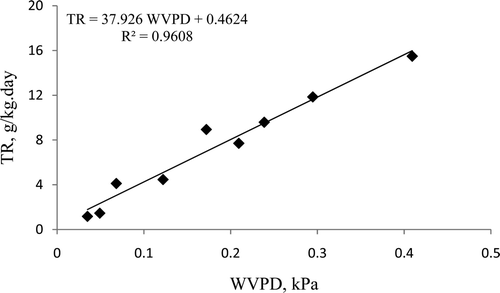
Relative humidity was the variable with greatest influence on TR. Increasing RH of the container from 76 to 96% decreased TR by 83.5% at 5°C, while decreasing the temperature from 15°C to 5°C decreased TR by 68.9%. A loss in produce weight is crucial to marketability. As little as a 3 to 10% loss in weight could have an adverse effect on the appearance, saleable weight, texture quality of fresh and FC produce (Ben-Yehoshua, Citation1987). In a related report, when RH of storage air for potatoes was decreased below 85%, more than 7% water loss was observed (Chourasia et al., Citation2005). Similarly, an increase in water loss during the ripe phase of “Hass” avocados was observed when the fruits where transferred from RH of 90 to 20%, Burdon et al. (Citation2005) reported a 30% increase in moisture loss when RH of stored apples was reduced from 97.5 to 95%. Based on Pareto analysis as seen in , temperature and RH, and their interaction had a significant impact on TR of pomegranate arils (p < 0.05). A similar result was reported by Mahajan, Oliveira, and Macedo (Citation2008), where the effect of temperature and RH was found to be significant on the TR of whole mushrooms. The effect of RH was more evident than that of temperature in this study and the interactive effects between temperature and RH were also significant. High RH and temperature increases the rate of deterioration, which is detrimental to fresh and fresh-cut fruits. As the RH in most sealed packaged fresh and fresh-cut fruits is close to saturation and fluctuations in temperature during storage and/or on transit may lead to water vapour condensation on both the film surface and produce, thus supporting the growth of pathogenic and spoilage microorganisms resulting in produce decay (Aharoni et al., Citation2008).
Figure 4. Pareto chart showing the effect of RH and temperature on transpiration rate of pomegranate arils, and both the interaction factors at p = 0.05 indicated with vertical dashed lines.
Figura 4. Gráfico de pareto mostrando el efecto de la humedad relativa y temperatura en la velocidad de transpiración de arilos de granada, y el efecto de sus interacciones para un p = 0,05 indicado por la línea discontinua vertical.
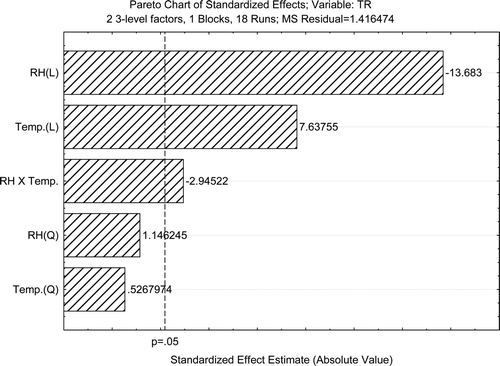
Quality of pomegranate arils
Texture in terms of firmness and pigment stability (colour) are very important attributes associated with high quality ready-to-eat pomegranate arils and, are directly related to consumer acceptance and commercial value (Gil, Artés, & Tomás-Barberán, Citation1996). After 8 days storage, firmness and colour of arils decreased with an increase in storage temperature. The least firm, with the highest percentage of decay, are the arils stored at 15°C and 96% RH (). The effect of increased temperature was more pronounced on visual quality, and this deleterious effect was enhanced at high RH (96%). However, the arils were best kept at 5°C and optimally with 96% RH. Arils stored at 5°C and 96% RH had the overall best keeping quality on the 8th day in comparison to those at 76 and 86% RH. Various lengths of shelf life have been reported in literature for pomegranate arils under different storage conditions, but none of these studies reported on storage-RH condition. Palma, Schirra, D'Aquino, La Malfa, and Continella (2009) reported a shelf life of 10 days for pomegranate (cv. Primosole) arils stored in 40 μm thick polypropylene film at 5°C. They observed no visible symptoms of decay or undesirable defects such as off-flavour and off-taste. López-Rubira, Conesa, Allende, and Artés (Citation2005) in their study on minimally fresh processed and UV-C treated pomegranate (cv. Mollar of Elche) arils, reported a shelf life of 14 and 10 days for early and late harvested fruit, respectively. An optimal storage RH is essential for successful extension of shelf-life of MAP-packed pomegranate arils to minimise losses during processing. Furthermore, based on these results, the quantification of TR would assist in developing optimal storage conditions and design of MAP for pomegranate arils.
Figure 5. A cluster graph of quality attributes (firmness, colour and decay incidence) of pomegranate arils after 8 days under different storage conditions.
Figura 5. Gráfico de cluster de los atributos de calidad (dureza, color e incidencia de deterioro) de arilos de granada después de 8 días en almacenamiento en diferentes condiciones.
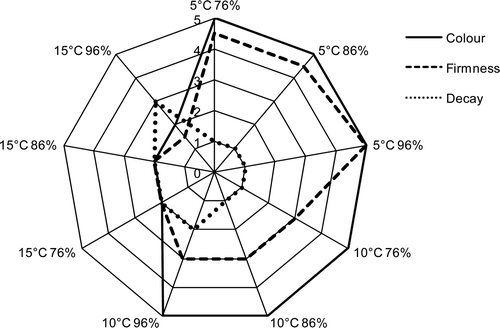
Model development and validation
The coefficient constant Ki
is determined by fitting Equation Equation(4) for each set of experimental conditions. Ki
was found to increase with temperature as shown in Supplementary , with R
2 values >99.5%. The increase in temperature created a higher shear stress or turbulence along the membrane surface and this, consequently, results in the observed correlation between our experimental temperatures and the coefficient constant Ki
. This phenomenon is similar to that reported by Mahajan, Oliveira, and Macedo (Citation2008), for mushrooms and, by Guiné, Henrriques, and Barroca (Citation2012) for the drying of pumpkin. Fitting Equation Equation(6)
with the experimental data at all combinations, the model described the change in mass adequately as shown with a R2
value of 94.3%, Ki
and a with standard error value of 89.96 (±6.87) and 0.09 (±0.01), respectively. Supplementary presents a good agreement between the observed and predicted mass of pomegranate arils. The values of mass of pomegranate predicted were in close agreement with those experimentally obtained. As expected, both the experimental data and the model prediction showed a decrease in mass with decrease in RH from 96 to 76% as well as with the decrease in temperature from 15 to 5°C. Similarly, a good agreement was obtained between the experimental and predicted TR by the model as shown in Supplementary . In order to validate the mathematical model, its predictions of TR at 8°C with 76, 86 and 96% RH were compared with experimental data. A good agreement was observed between experimental and predicted TR, at 8°C. The experimental TR at RH of 76, 86 and 96% were 9.93 (±0.83), 5.50 (±0.11) and 1.5 (±0.59) g/kg day, respectively, while the model predicted TR's were 10.5, 5.8 and 1.1 g/kg day at the respective RH. Similarly, the predicted TR also decreased with the increase in RH, once more highlighting the influence of RH. These results therefore confirm the predictive ability of the model.
Packaging needs
One of the ways to reduce weight loss in fresh produce is by appropriate packaging, because this helps to maintain high RH inside the package thereby reducing the effect of WVPD. However, the selection of appropriate packaging material is critical towards achieving the optimum produce quality and to create a stable pre-determined RH in sealed fresh produce packages. The generally recommended level of 85 to 95% RH for storage of fresh produce represents a compromise to prevent excessive weight loss while providing some control of microbial spoilage (Hardenburg, Watada, & Wang, Citation1986). Optimising the permeability of barriers such as films in order to avoid deterioration in quality of food would be valuable for the success of MAP. From the target WVTR determination using Equation Equation(9), it was observed that the target WVTR for maintaining RH of 90% inside package varied from 33 to 68 g/m2 day for the temperature range of 5 to 15°C as shown in Supplementary . Hence, the existing packaging films such as polycarbonate, poly-lactic acid, polyamide and cellulose films would be suitable for packaging pomegranate arils.
Conclusions
Weight loss of pomegranate arils increased with higher WVPD, and weight loss was highest at experimental combinations of 15°C with 76% RH. Additionally, RH was the variable with the greatest influence on TR, and arils were best kept at 5°C and 96% RH. This highlights the significance of maintaining an optimal produce storage condition. The applicability of the transpiration model developed was verified based on adequate prediction of TR of pomegranate arils during storage at different combinations of temperature and RH. The model would be useful towards understanding the rate of water loss as affected by temperature and RH over time, thus providing a valuable guide for the storage and design of MAP-system for pomegranate arils. Experimental and model prediction results showed that both RH and temperature had significant effects on TR and quality of stored arils, highlighting the need to maintain optimal storage condition to assure high quality ready-to-eat pomegranate arils with maximum shelf-life.
Supplementary material
The supplementary material for this article is available at http://dx.doi.org/10.1080/19476337.202012.721807.
Supplementary Figure 1. Variation of coefficient Ki of the model EquationEquation (4) with temperature and RH. (♦ 76 %, ▪ 86 %, ▴ 96 %).
Figura adicional 1. Variacioen del coeficiente Ki del modelo Ecn. 4 con temperatura y HR. (♦ 76 %, ▪ 86 %, ▴ 96 %).
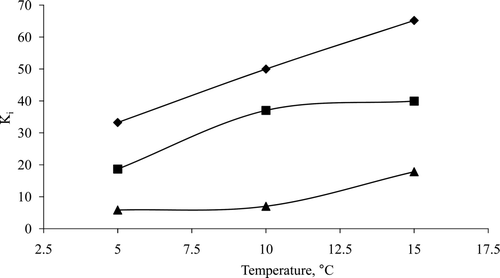
Supplementary figure 2. Relationship between experimental and predicted values of pomegranate aril mass.
Figura adicional 2. Relacioen entre los valores experimental y previsto de masa de arilo de granada.
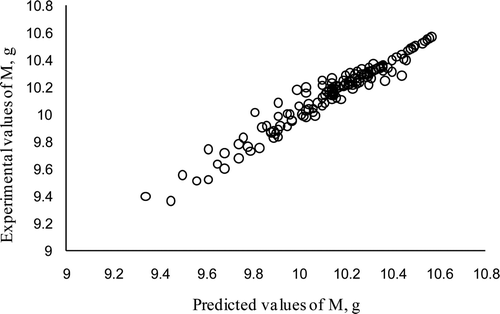
Supplementary figure 3. Relationship between experimental and predicted transpiration rate (TR) for pomegranate arils using EquationEquation (3).
Figura adicional 3. Relacioen entre las tasas de transpiracioen (TT) experimental y prevista para arilos de granada usando la Ecn. 4.
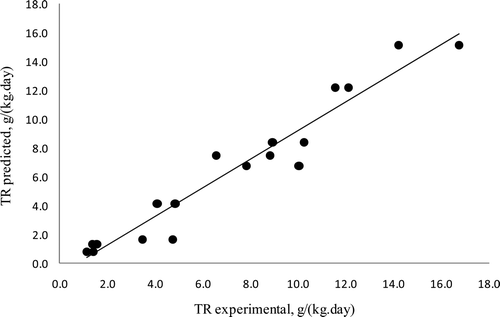
Supplementary figure 4. Target WVTR derived with temperature and relative humidity using EquationEquation (9).
Figura adicional 4. DPVA objetivo derivado con temperatura y humedad relativa usando la ecuacioen (9).
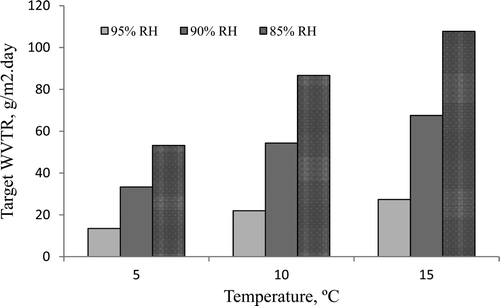
Nomenclature
| a | = |
constant parameter |
| aw | = |
water activity of the container (RH/100) |
| awi | = |
water activity of arils |
| Ki | = |
mass transfer coefficient |
| M | = |
mass of arils (g) |
| Mi | = |
initial mass of arils (g) |
| RH | = |
relative humidity (%) |
| T | = |
storage temperature (°C) |
| t | = |
storage time (day) |
| TR | = |
transpiration rate (g/kg day) |
Supplementary Figures 1-4
Download PDF (54.8 KB)Acknowledgements
This work is based upon research supported by the South African Research Chairs Initiative of the Department of Science and Technology and National Research Foundation. The authors are grateful to Citrogold Ltd and Perishable Products Export Control Board (PPECB) for financial support, Mr Fan Olivier of Houdconstant Pack-house Porterville and Mr Gerrit Nieuwoudt of Colorsfruit for assistance with fruit procurement, and Stellenbosch University Postgraduate International Office Overseas Research Visit (PGIO-ORV) travel grant awarded to Mr O.J. Caleb.
References
- Aharoni , N. , Rodov , V. , Fallik , E. , Porat , R. , Pesis , E. and Lurie , S . 2008 . Controlling humidity improves efficacy of modified atmosphere packaging of fruits and vegetables . Acta Horticulturae , 804 : 121 – 128 .
- Ben-Yehoshua , S. 1987 . “ Transpiration, water stress, and gas exchange ” . In Postharvest physiology of vegetables , Edited by: Weichmann , J. 113 – 170 . New York , NY : Marcel Dekker Inc .
- Burdon , J. , Lallu , N. , Haynes , G. , Fancis , K. , Pidakala , P. and Billing , D . Mode of action of water loss on fruit quality of ‘Hass’ avocados . New Zealand and Australia avocado grower's conference . September 20–22 .
- Caleb , O.J. , Opara , U.L. and Witthuhn , C . 2012 . Modified atmosphere packaging of pomegranate fruit and arils: A review . Food and Bioprocess Technology , 5 ( 1 ) : 15 – 30 .
- Caleb , O.J. , Mahajan , P.V. , Al-Said , F.A. and Opara , U.L . 2012 . Modified atmosphere packaging technology of fresh and fresh-cut produce and the microbial consequences – A review . Food and Bioprocess Technology , 5 : 15 – 30 . doi: 10.1007/s11947–012–0932–4
- Chourasia , M.K. , Maji , P. , Baskey , A. and Goswami , T.K . 2005 . Estimation of moisture loss from the cooling data of potatoes . Journal of Food Process Engineering , 28 : 397 – 416 .
- Gil , M.I. , Artés , F. and Tomás-Barberán , F.A . 1996 . Minimal processing and modified atmosphere packaging effects on pigmentation of pomegranate seeds . Journal of Food Science , 61 ( 1 ) : 161 – 164 .
- Guiné , R.P.F. , Henrriques , F. and Barroca , M.J . 2012 . Mass transfer coefficient for the drying of pumpkin (Cucurbita moschata) and dried product quality . Food and Bioprocess Technology , 5 ( 1 ) : 176 – 183 .
- Hardenburg , R.E. , Watada , A.E. and Wang , C.Y . 1986 . The commercial storage of fruits, vegetables, and florist and nursery stocks , Washington, D.C.: U.S. Dept. Agr . Number 66, USDA-ARS Handbook
- Leonardi , C. , Baille , A. and Guichard , S . 1999 . Effects of fruit characteristics and climatic conditions on tomato transpiration in greenhouse . Journal of Horticultural Science and Biotechnology , 74 : 748 – 756 .
- Lichter , A. , Kaplunov , T. , Zutahy , Y. , Daus , A. , Alchanatis , V. , Ostrovsky , V. and Lurie , S . 2011 . Physical and visual properties of grape rachis as affected by water vapour pressure deficit . Postharvest Biology and Technology , 59 : 25 – 33 .
- López-Rubira , V. , Conesa , A. , Allende , A. and Artés , F . 2005 . Shelf life and overall quality of minimally processed pomegranate arils modified atmosphere packaged and treated with UV-C . Postharvest Biology and Technology , 37 : 174 – 185 .
- Mahajan , P.V. , Oliveira , F.A.R. and Macedo , I . 2008 . Effect of temperature and humidity on the transpiration rate of the whole mushrooms . Journal of Food Engineering , 84 : 281 – 288 .
- Nunes , M.C.N. , Emond , J-P. , Dea , S. and Yagiz , Y . 2011 . Distribution centre and retail conditions affect the sensory and compositional quality of bulk and packaged slicing cucumbers . Postharvest Biology and Technology , 59 : 280 – 288 .
- Ochoa-Martínez , L.A. , Gallegos-Infante , J.A. , Morales-Castro , J. , Medrano-Roldán , H. and Rocha-Guzmán , N.E . 2004 . Mathematical model for prediction of moisture content in jalapeño pepper (Capsicum frutescens) . Ciencia y Tecnologia Alimentaria , 4 : 154 – 157 .
- Opara , U.L. , Al-Ani , M.R. and Al-Shuaibi , Y.S . 2009 . Physico-chemical properties, vitamin C content, and antimicrobial properties of pomegranate fruit (Punica granatum L.) . Food Bioprocess Technology , 2 : 315 – 321 .
- Palma , A. , Schirra , M. , D'Aquino , S. , La , Malfa, S. and Continella , G . 2009 . Chemical properties changes in pomegranate seeds packaged in polypropylene trays . Acta Horticulturae , 818 : 323 – 330 .
- Patel , P.N. , Pai , T.K. and Sastry , S.K . 1988 . Effects of temperature, relative humidity and storage time in the transpiration coefficients of selected perishables . Transactions of the ASHRAE , 94 ( 1) : 1563 – 1587 .
- Ríos-Romero , E. , Tabilo-Munizaga , G. , Morales-Castro , J. , Reyes , J.E. , Pérez-Won , M. and Ochoa-Martinez , L.A . 2012 . Effect of high hydrostatic pressure processing on microbial inactivation and physicochemical properties of pomegranate arils . Ciencia y Tecnologia Alimentaria , 10 : 152 – 159 .
- Sastry , S.K. and Buffington , D.E . 1982 . Transpiration rates of stored perishable commodities: A mathematical model and experiments on tomatoes . Transactions of the ASHRAE , 88 : 159 – 184 .
- Song , Y. , Lee , D.S. and Yam , K.L . 2001 . Predicting relative humidity in modified atmosphere packaging system containing blueberry and moisture absorbent . Journal of Food Processing and Preservation , 25 : 49 – 70 .
- Song , Y. , Vorsa , N. and Yam , K.L . 2002 . Modelling respiration-transpiration in modified atmosphere packaging system containing blueberry . Journal of Food Engineering , 53 : 103 – 109 .
- Viuda-Martos , M. , Fernández-López , J. and Pérez-Álvarez , J.A . 2010 . Pomegranate and its many functional components as related to human health: A review . Comprehensive Reviews in Food Science and Food Safety , 9 : 635 – 654 .